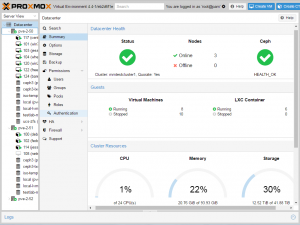Difference between revisions of "Main Page"
m |
(Add spamtrap email address) |
||
| Line 62: | Line 62: | ||
</tr> | </tr> | ||
</TABLE> | </TABLE> | ||
| + | |||
| + | <!-- T.r.a.p <a href="mailto:user2@test.proxmox.org">do not use this address</a> --> | ||
Revision as of 10:55, 25 November 2017
|
Today, 16 April 2024, there are 244 articles available. Proxmox Virtual Environment is an open source server virtualization management solution based on QEMU/KVM and LXC. You can manage virtual machines, containers, highly available clusters, storage and networks with an integrated, easy-to-use web interface or via CLI. Proxmox VE code is licensed under the GNU Affero General Public License, version 3. The project is developed and maintained by Proxmox Server Solutions GmbH. For an overview of the main Proxmox VE features see the datasheet. DownloadsDownload our latest ISO image. InstallationYou can install Proxmox VE either on your hardware from USB or CD-ROM using our ISO image, or alternatively on top of an existing Debian installation. Using Proxmox VEThis wiki includes the complete Proxmox VE Reference Documentation. If you are new to Proxmox VE the following chapters will help you to start:
Offline DocumentationThe complete Proxmox VE Reference Documentation is also available offline in different formats such as html, pdf, epub at http://pve.proxmox.com/pve-docs/ This documentation is also included in each PVE installation, and is accessible via contextual help buttons. HOWTOs & Troubleshooting
Release History and RoadmapTake a look on the Roadmap for upcoming features. Video TutorialsFor new Proxmox VE users, we regularly publish video tutorials on our website, see http://www.proxmox.com/training/video-tutorials. Testimonials9,500+ companies, universities, public institutions and NGOs use Proxmox VE in production environment. Take a look on our testimonials page. |
